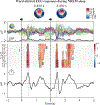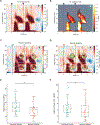Updating memories of unwanted emotions during human sleep
- PMID: 36584677
- PMCID: PMC9979073
- DOI: 10.1016/j.cub.2022.12.004
Updating memories of unwanted emotions during human sleep
Abstract
Post-learning sleep contributes to memory consolidation. Yet it remains contentious whether sleep affords opportunities to modify or update emotional memories, particularly when people would prefer to forget those memories. Here, we attempted to update memories during sleep, using spoken positive words paired with cues to recent memories of aversive events. Affective updating using positive words during human non-rapid eye movement (NREM) sleep, compared with using neutral words instead, reduced negative affective judgments in post-sleep tests, suggesting that the recalled events were perceived as less aversive. Electroencephalogram (EEG) analyses showed that positive words modulated theta and spindle/sigma activity; specifically, to the extent that theta power was larger for the positive words than for the memory cues that followed, participants judged the memory cues less negatively. Moreover, to the extent that sigma power was larger for the positive words than for the memory cues that followed, participants forgot more episodic details about aversive events. Notably, when the onset of individual positive words coincided with the up-phase of slow oscillations (a state characterized by increased cortical excitability during NREM sleep), affective updating was more successful. In sum, we altered the affective content of memories via the strategic pairing of positive words and memory cues during sleep, linked with EEG theta power increases and the slow oscillation up-phase. These findings suggest novel possibilities for modifying unwanted memories during sleep, which would not require people to consciously confront memories that they prefer to avoid.
Keywords: memory editing; sleep learning; sleep spindle; slow oscillation; targeted memory reactivation; theta power.
Copyright © 2022 Elsevier Inc. All rights reserved.
Conflict of interest statement
Declaration of interests The authors declare no competing interests.
Figures





Similar articles
-
Aversive memories can be weakened during human sleep via the reactivation of positive interfering memories.Proc Natl Acad Sci U S A. 2024 Jul 30;121(31):e2400678121. doi: 10.1073/pnas.2400678121. Epub 2024 Jul 25. Proc Natl Acad Sci U S A. 2024. PMID: 39052838 Free PMC article.
-
Positive and neutral updating reconsolidate aversive episodic memories via different routes.Neurobiol Learn Mem. 2021 Oct;184:107500. doi: 10.1016/j.nlm.2021.107500. Epub 2021 Aug 10. Neurobiol Learn Mem. 2021. PMID: 34389448
-
Emotional arousal modulates oscillatory correlates of targeted memory reactivation during NREM, but not REM sleep.Sci Rep. 2016 Dec 16;6:39229. doi: 10.1038/srep39229. Sci Rep. 2016. PMID: 27982120 Free PMC article.
-
The whats and whens of sleep-dependent memory consolidation.Sleep Med Rev. 2009 Oct;13(5):309-21. doi: 10.1016/j.smrv.2008.08.002. Epub 2009 Feb 28. Sleep Med Rev. 2009. PMID: 19251443 Review.
-
[Episodic autobiographical memory in depression: a review].Encephale. 2006 Oct;32(5 Pt 1):781-8. doi: 10.1016/s0013-7006(06)76231-5. Encephale. 2006. PMID: 17099603 Review. French.
Cited by
-
Updating social evaluation during sleep.NPJ Sci Learn. 2025 Aug 30;10(1):65. doi: 10.1038/s41539-025-00356-9. NPJ Sci Learn. 2025. PMID: 40885761 Free PMC article.
-
Reactivating cue approached positive personality traits during sleep promotes positive self-referential processing.iScience. 2024 Jun 21;27(7):110341. doi: 10.1016/j.isci.2024.110341. eCollection 2024 Jul 19. iScience. 2024. PMID: 39055925 Free PMC article.
-
Modulating social learning-induced evaluation updating during human sleep.NPJ Sci Learn. 2024 Jul 7;9(1):43. doi: 10.1038/s41539-024-00255-5. NPJ Sci Learn. 2024. PMID: 38971834 Free PMC article.
-
Item-specific neural representations during human sleep support long-term memory.PLoS Biol. 2023 Nov 20;21(11):e3002399. doi: 10.1371/journal.pbio.3002399. eCollection 2023 Nov. PLoS Biol. 2023. PMID: 37983253 Free PMC article.
-
Overnight neuronal plasticity and adaptation to emotional distress.Nat Rev Neurosci. 2024 Apr;25(4):253-271. doi: 10.1038/s41583-024-00799-w. Epub 2024 Mar 5. Nat Rev Neurosci. 2024. PMID: 38443627 Review.
References
-
- Talamini LM, and Juan E (2020). Sleep as a window to treat affective disorders. Curr. Opin. Behav. Sci 33, 99–108. 10.1016/j.cobeha.2020.02.002. - DOI
Publication types
MeSH terms
Grants and funding
LinkOut - more resources
Full Text Sources
Medical

